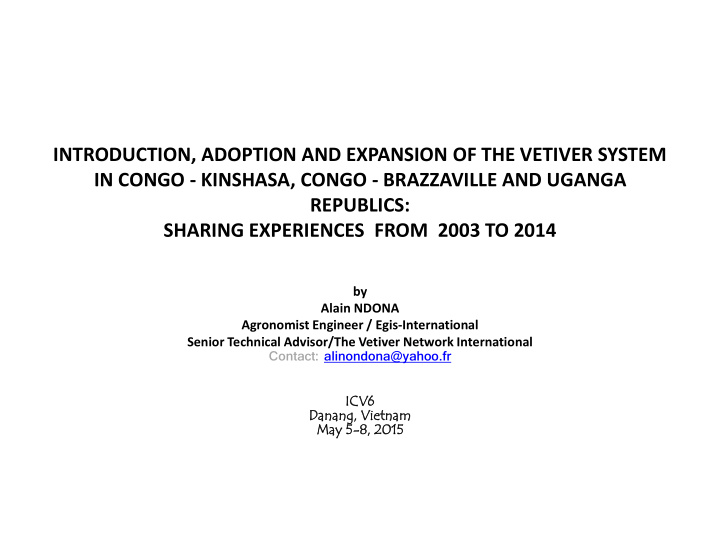



INTRODUCTION, ADOPTION AND EXPANSION OF THE VETIVER SYSTEM IN CONGO - KINSHASA, CONGO - BRAZZAVILLE AND UGANGA REPUBLICS: SHARING EXPERIENCES FROM 2003 TO 2014 by Alain NDONA Agronomist Engineer / Egis-International Senior Technical Advisor/The Vetiver Network International Contact: alinondona@yahoo.fr ICV6 Danang, , Vietn tnam am May y 5-8, , 2015 15
Outline INTRODUCTION PROJECT LOCATION AND CONTEXT METHODOLOGY - Advocacy toward policy makers and construction companies - Popularization of vetiver towards the local population as potential nurserymen or suppliers - Small scale demonstrations RESULTS CONCLUSION
1. INTRODUCTION • Despite its many benefits, vetiver technology often faces some barriers which hinder its adoption and its large-scale use. • The experience learned from Congo-Kinshasa, Congo-Brazzaville and Uganda since 2003 until 2014 indicates that these barriers are centered around four different major actors: 1. Policy makers; 2. Companies involved in infrastructures projects implementation; 3. Local people; and 4. People involved in vetiver technology popularization. • These four actors simultaneously play very important roles in the success or failure of the adoption and expansion of vetiver technology in any country. • This presentation aims to share experiences from projects in which the vetiver system has been successfully introduced, adopted and widely used in this part of Africa.
3. METHODOLOGY 3.1. Advocacy and/or lobbying to decision makers Numerous meetings were held with decision makers (lead construction managers) to convince them of the importance of using vetiver on different road projects and the fight against erosion, concentrating on vetiver’s low maintenance costs and its ability to insure long-term sustainability of the roads being built.
3. METHODOLOGY 3.2. Advocacy and/or lobbying to decision makers This stage is a difficult one as most of the construction companies prefer more expensive solutions as they can obtain higher profits.
3. METHODOLOGY: 3.3. Promoting vetiver to local communities to increase supply and availability of vetiver plants Promotion at the community level includes providing basic agricultural tools to be used to create community-based nurseries for vetiver multiplication. 100 nurseries were created this way.
On-site training for vetiver propagation in community nurseries
Several nurseries were created just for specific projects. This shows an eight hectare nursery which produced more than 20 million slips used for a road project in Congo Brazzaville going from Pointe Noir on the coast inland to the capital Brazzaville.
3. METHODOLOGY 3.4. Small scale demonstrations of vetiver technology With USAID funds, two urban ravines were stabilized in 2005-06 in Kikwit, Congo-Kinshasa as a means to demonstrate the effectiveness of vetiver in urban settings. Each ravine covered several hectares.
Kikwit ravine in Congo-Kinshasa, initial status Kikwit ravine 12 months later totally stabilized with vetiver
Erosion control demonstration in Boukeni Congo-Brazzaville Placing bags containing topsoil Initial status at the Boukeni and vetiver planting on the ravine, before placing sandbags Boukeni site (February 2009) containing soil and planting vetiver
The Vetiver system was successfully tested on a small part of a vulnerable embankment before the large scale use on the Congo Brazzaville-Pointe Noire highway project
Road Stabilization This road connects the city of Fortpotal and Bundibugyo in Uganda, a project implemented by FEMISA International in August 2013 August 2013 May 2014
4. RESULTS Country Years Project ID Funded by Partners Slips used DRC 2003-06 CLIFS USAID IRM/TVNI 300,000 2007 RN 1 BCMI/GUAFF SOGEA 1,000,000 2004-08 Selembao World Bank BCM/Egis 500,000 2014-present Gire UNEP MEDD 30,000 Congo – Brazzaville 2008-10 Casis GoCB Egis 900,000 2008-13 Boukeni GoCB Egis 450,000 2009-13 Pylône GoCB Egis 400,000 2009-13 Mimi GoCB Egis 600,000 2011-present RN 1 GoCB Egis 30,000,000 2014-present RN 2 GoCB Egis 150,000 2014-present Corniche GoCB SGI/DGGT 80,000 Brazzaville 2014-present Off ramp GoCB Egis 40,000 Brazzaville 2014-present Emeraude GoCB Egis 200,000
4.1. Some Congo-Kinshasa projects REHABILITATION OF THE NATIONAL Highway N ° 1 funded by the World Bank One million vetiver slips were used
Congo-Kinshasa National Highway 1 Project funded by the World Bank More than 1 million of vetiver slips were planted to prevent embankment erosion and stabilize this road’s infrastructure at vulnerable locations.
4.1. Some Congo-Kinshasa projects EROSION CONTROL PROJECT IN DREVE DE SELEMBAO SITE, KINSHASA funded by the World Bank More than 500,000 vetiver slips were used
4.2. Some Congo-Brazzaville projects EROSION CONTROL PROJECT AT BRAZZAVILLE URBAN SETTLEMENT funded by the Congo-Government The integration of Vetiver System as a bio-engineering technology into the conventional erosion control techniques has been a very successful new approach to halt the progression of erosion and to ensure protection and sustainability of conventional structures built there.
Boukeni urban erosion project in Congo-Brazzaville, more than 450,000 vetiver slips were used Conventional structural work and vetiver planting in progress, November 2012 Same site totally stabilized, May 2014
Casis erosion project in Congo-Brazzaville where at least 900,000 vetiver slips were used Conventional structural work and vetiver planting in progress, November 2009 It remains totally stabilized, May 2014
4.2. Some Congo-Brazzaville projects POINTE NOIRE TO BRAZZAVILLE HIGHWAY PROJECT funded by the Congo-Government This is the largest project using vetiver for embankment stabilization in any of the Central African countries, with more than 30 million vetiver slips being planted by the project than ends in 2016.
Highway embankments totally protected with vetiver, NO erosion recorded since the vetiver was planted
CONCLUSION This presentation has shown that the Vetiver system has been successfully implemented, and is expanding in Congo-Kinshasa, Congo-Brazzaville and Uganda Republics. The transfer of this green technology has been implemented on 13 projects, with 28 partners involved and more than 34,540,000 vetiver slips planted from 2003 to 2014. Policy makers, construction companies, local communities and vetiver experts play simultaneously very important roles in the success or failure of the adoption and expansion of vetiver technology into any country.
Recommend
More recommend